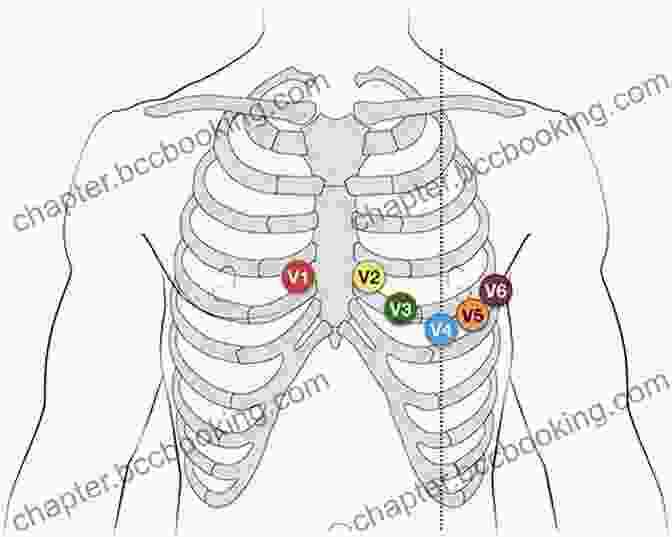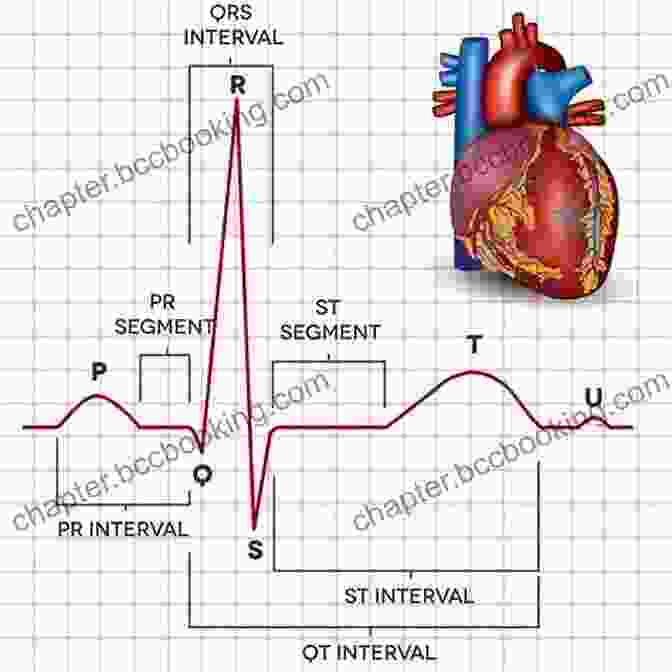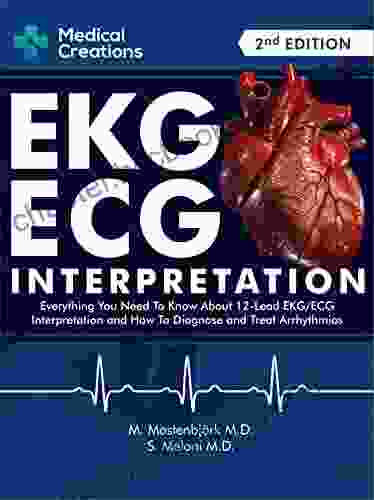Unlocking the Secrets of Electrical Heart Activity: A Comprehensive Guide to 12-Lead ECG Interpretation

The 12-lead electrocardiogram (ECG or EKG) is a non-invasive medical test that records the electrical activity of the heart. It is a vital tool in diagnosing and managing various cardiac conditions. Understanding how to interpret a 12-lead ECG is essential for healthcare professionals and individuals who want to take charge of their heart health. This comprehensive article delves into the intricacies of 12-lead ECG interpretation, empowering you with the knowledge to navigate the world of electrical heart activity.
Section 1: Basics of ECG Interpretation

4.5 out of 5
| Language | : | English |
| File size | : | 248150 KB |
| Text-to-Speech | : | Enabled |
| Screen Reader | : | Supported |
| Enhanced typesetting | : | Enabled |
| Print length | : | 272 pages |
| Lending | : | Enabled |
Electrical Conduction System of the Heart
The heart's electrical conduction system orchestrates the rhythmic contractions that pump blood throughout the body. The sinus node, located in the right atrium, initiates each heartbeat by generating an electrical impulse. This impulse travels through the atrioventricular node, down the bundle of His, and into the left and right bundle branches. It then spreads across the ventricular muscle, causing the heart to contract.
ECG Leads and Viewpoints
The 12-lead ECG uses 10 electrodes placed on specific locations of the chest, arms, and legs. These electrodes record the electrical activity from different viewpoints, providing a comprehensive picture of the heart's electrical activity. The 12 leads are divided into three groups:
* Limb leads (I, II, III): Measure the electrical activity in the frontal plane of the heart. * Chest leads (V1-V6): Measure the electrical activity in the horizontal plane of the heart. * Augmented limb leads (aVR, aVL, aVF): Measure the electrical activity in the opposite direction of limb leads I, II, and III.
Section 2: Normal ECG Waveforms

ECG Components
A normal ECG waveform consists of several waves and intervals that represent specific phases of the heart's electrical cycle. These components include:
* P wave: Represents atrial depolarization. * QRS complex: Represents ventricular depolarization. * T wave: Represents ventricular repolarization. * U wave: Represents late ventricular repolarization (not always visible). * PR interval: Represents the time from the beginning of the P wave to the beginning of the QRS complex. * QRS interval: Represents the time from the beginning of the QRS complex to the end of the S wave. * QT interval: Represents the time from the beginning of the QRS complex to the end of the T wave.
Section 3: ECG Interpretation in Practice
Interpreting a 12-lead ECG involves analyzing the wave morphology, measuring intervals, and correlating the findings with clinical information. Here are some key principles:
Heart Rate and Rhythm
* The heart rate can be calculated by counting the number of QRS complexes in a 10-second segment and multiplying by 6. * Normal heart rates range from 60 to 100 beats per minute (bpm). * Arrhythmias are abnormal heart rhythms that can be detected by ECG, such as atrial fibrillation or ventricular tachycardia.
Axis Deviation
* The electrical axis of the heart is the average direction of the electrical impulses during ventricular depolarization. * Normal axis deviation ranges from -30 to +90 degrees. * Abnormal axis deviation can indicate underlying heart conditions, such as right or left ventricular hypertrophy.
Chamber Enlargement
* Enlarged atria can cause increased P wave amplitude or prolonged PR interval. * Enlarged ventricles can cause increased QRS amplitude or widened QRS interval.
Ischemia and Infarction
* Ischemia (reduced blood flow to the heart) can cause ST segment changes, such as ST elevation or depression. * Infarction (heart attack) can cause Q waves, which represent areas of damaged heart muscle.
Section 4: Advanced ECG Interpretation
Beyond the basics, advanced ECG interpretation techniques can provide more detailed information about the heart's function. These techniques include:
Vectorcardiography
* Vectorcardiography is a graphical representation of the electrical activity of the heart in three dimensions. * It can help identify abnormalities that may not be apparent in a standard 12-lead ECG.
Signal Averaging
* Signal averaging is a technique that enhances the ECG signal by removing background noise. * It can help detect low-amplitude arrhythmias or other abnormalities that may be difficult to see on a regular ECG.
Holter Monitoring
* Holter monitoring is a continuous ECG recording that can be worn for 24 hours or longer. * It can identify intermittent arrhythmias or other abnormalities that may not be captured in a short-term ECG recording.
Section 5: ECG in Clinical Practice
The 12-lead ECG is widely used in various clinical settings, including:
* Emergency medicine: Diagnosing acute cardiac conditions, such as myocardial infarction or arrhythmias. * Cardiology: Evaluating and managing heart disease, such as coronary artery disease or heart failure. * Perioperative care: Monitoring patients during surgery or other procedures that require cardiac support. * Sports medicine: Assessing the cardiovascular health of athletes before and after exercise.
掌握12导联心电图(ECG或EKG)的解读是一项非常有价值的技能,可以帮助你了解你的心脏健康状况。这篇文章提供了12导联心电图解读的关键基础知识,让你对心脏的电活动有一个全面的了解。通过持续学习和实践,你将能够更准确地解读心电图,帮助你做出明智的健康决策。记住,心电图解读是一项持续学习的过程,随着新技术和知识的出现,始终有新的领域需要探索。
4.5 out of 5
| Language | : | English |
| File size | : | 248150 KB |
| Text-to-Speech | : | Enabled |
| Screen Reader | : | Supported |
| Enhanced typesetting | : | Enabled |
| Print length | : | 272 pages |
| Lending | : | Enabled |
Do you want to contribute by writing guest posts on this blog?
Please contact us and send us a resume of previous articles that you have written.
 Book
Book Novel
Novel Page
Page Chapter
Chapter Text
Text Story
Story Genre
Genre Reader
Reader Library
Library Paperback
Paperback E-book
E-book Magazine
Magazine Newspaper
Newspaper Paragraph
Paragraph Sentence
Sentence Bookmark
Bookmark Shelf
Shelf Glossary
Glossary Bibliography
Bibliography Foreword
Foreword Preface
Preface Synopsis
Synopsis Annotation
Annotation Footnote
Footnote Manuscript
Manuscript Scroll
Scroll Codex
Codex Tome
Tome Bestseller
Bestseller Classics
Classics Library card
Library card Narrative
Narrative Biography
Biography Autobiography
Autobiography Memoir
Memoir Reference
Reference Encyclopedia
Encyclopedia Michael H Hodges
Michael H Hodges Michael Massen
Michael Massen Michael Sean Comerford
Michael Sean Comerford Mteto Nyati
Mteto Nyati Prabhu Tl
Prabhu Tl Prabhat Patnaik
Prabhat Patnaik Mike Chaplin
Mike Chaplin Noah Jones
Noah Jones Thane K Pratt
Thane K Pratt Michelle Lawson
Michelle Lawson Misty M Beller
Misty M Beller Tim Robinson
Tim Robinson Michael Fazio
Michael Fazio Miranda Seymour
Miranda Seymour Mike Jacker
Mike Jacker Michealene Cristini Risley
Michealene Cristini Risley Nicholas Wade
Nicholas Wade Tanya Lloyd Kyi
Tanya Lloyd Kyi Monica Leonelle
Monica Leonelle Michael G Long
Michael G Long
Light bulbAdvertise smarter! Our strategic ad space ensures maximum exposure. Reserve your spot today!
 Quentin PowellThe Legacy of an American Icon: A Journey Through the Life of Elvis Presley
Quentin PowellThe Legacy of an American Icon: A Journey Through the Life of Elvis Presley
 Aldous HuxleyUnlocking Customer Insights in the Global Marketplace: Analyzing and Managing...
Aldous HuxleyUnlocking Customer Insights in the Global Marketplace: Analyzing and Managing...
 Jonathan HayesMiddle School Counselor Diary Of Working Day: An Unforgettable Journey into...
Jonathan HayesMiddle School Counselor Diary Of Working Day: An Unforgettable Journey into... Charlie ScottFollow ·17.5k
Charlie ScottFollow ·17.5k Wesley ReedFollow ·14.5k
Wesley ReedFollow ·14.5k Arthur C. ClarkeFollow ·10.5k
Arthur C. ClarkeFollow ·10.5k Herman MitchellFollow ·4.6k
Herman MitchellFollow ·4.6k Jesus MitchellFollow ·4.1k
Jesus MitchellFollow ·4.1k Robert Louis StevensonFollow ·3.8k
Robert Louis StevensonFollow ·3.8k Anthony WellsFollow ·6.7k
Anthony WellsFollow ·6.7k Nick TurnerFollow ·13.3k
Nick TurnerFollow ·13.3k

 Trevor Bell
Trevor BellUncover the Thrilling Mystery in "It Ain't Over, Cole...
Prepare yourself...

 Garrett Bell
Garrett BellHow to Stay True to Yourself and Stand Out From the Crowd
In a world that...

 Dennis Hayes
Dennis HayesDrill Instructor Strategies And Tactics For Success
Unleash Your Inner Warrior and Conquer...

 Guy Powell
Guy Powell101 Awesome Women Who Changed Our World: A Celebration of...
Throughout history,...

 Ashton Reed
Ashton ReedAn Iraq War Tank Commander's Inspirational Memoir of...
When he was just 19 years old, John Q....

 Dean Cox
Dean CoxLady Trader in the Transvaal: A Literary Safari through a...
Prologue: A Journey into the...
4.5 out of 5
| Language | : | English |
| File size | : | 248150 KB |
| Text-to-Speech | : | Enabled |
| Screen Reader | : | Supported |
| Enhanced typesetting | : | Enabled |
| Print length | : | 272 pages |
| Lending | : | Enabled |






